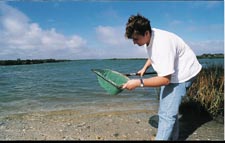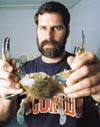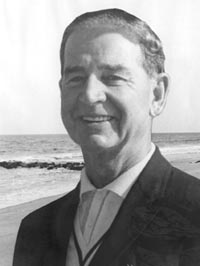Simple Accessible Marine Animals Are Research Focus at UF's Whitney Laboratory
By Patricia Bates McGhee
 Nine-eyed horseshoe crabs, spiny lobsters with noses at the ends of
their antennae, jellyfish with tentacles dangling beneath them.
Nine-eyed horseshoe crabs, spiny lobsters with noses at the ends of
their antennae, jellyfish with tentacles dangling beneath them.
These may sound like creatures from a Saturday matinee, but they actually are some of the animal models used by researchers at the University of Florida’s Whitney Laboratory.
 (jellyfish)
(jellyfish)
"We seek to capitalize on the experimental advantages of certain marine animals — their structural simplicity, the presence of ‘giant’ cells and the accessibility of certain structures such as their noses, eyes or nervous systems," says lab Director Peter Anderson. "Inherent in this approach is the fact that the biology of animals as simple as jellyfish, crabs or snails is essentially the same as our own. In many cases, they’re just easier to work with."
For more than 25 years now, Whitney Lab biomedical researchers have been studying some of the planet’s simplest animals to unlock 700-million-year-old secrets about how we smell, see and even think.
 Since its
founding in 1974, the laboratory’s goals have been to use marine organisms
in basic biomedical research; apply the novel results of that research
to problems of human health, natural resources and the environment; train
future experimental biologists; and contribute to public education and
to policy formulation for basic research and marine science.
Since its
founding in 1974, the laboratory’s goals have been to use marine organisms
in basic biomedical research; apply the novel results of that research
to problems of human health, natural resources and the environment; train
future experimental biologists; and contribute to public education and
to policy formulation for basic research and marine science.
"We are a basic-science research unit," says Anderson. "We are not directly clinically involved, but a lot of the information we’re getting will have applications in the long run."
Anderson adds that only a few labs, particularly the Marine Biological Laboratory at Woods Hole and Stanford’s Hopkins Marine Station, take this basic-science approach.
The Whitney Lab has 13 faculty researchers and some 40 associates, students and visiting scientists studying such complex topics as physiology and biochemistry of vision and smell, synaptic physiology, molecular biology, neurotransmitter chemistry and pharmacology, reproductive and developmental biology of vertebrates, and toxicology.
The scientists research these topics by examining the biological systems of marine animals. Then they apply that information to human health, veterinary medicine, the environment and aquaculture. And their study subjects are not only readily available — they’re just a short walk or boat ride away.
Located in the town of Marineland just south of St. Augustine, Whitney Lab is ideally situated for its function. The eight-acre facility sits on a narrow barrier island between the Atlantic Ocean and the Intracoastal Waterway and near the Matanzas Inlet and all the associated streams, creeks and productive marshlands. Within a three-mile radius of the lab are examples of every coastal habitat in Florida, with the exception of coral reefs and red mangroves. Because much of the surrounding land is owned by federal, state and local governments, it is protected from development. In fact, more than 7,000 acres adjacent to the Whitney campus are now set aside in perpetuity.
Creature Feature
Spiny lobsters wear their noses on their sleeves, so to speak. Extending from their heads on the top branch of a slender set of antennae, lobsters’ noses are a lot easier to study than humans’. And, lobsters’ sense of smell evolved very early and has stayed the same for eons.
"The basic organizational plan of the olfactory pathway has been conserved in evolution," says zoology and neuroscience Professor Barry Ache. "As a result, fundamental principles of how we smell can be learned from studying animal models such as the Caribbean spiny lobster.
 "Odors
typically are complex blends of chemicals that the brain discriminates
by the unique pattern of neural activity each odor generates across many
neurons; there are not specific neurons for specific odors," Ache continues.
"We are trying to decipher the neural and biochemical processes that give
rise to these patterns in the nose and, subsequently, shape them in the
brain. Our goal is to ultimately understand how the brain recognizes and
discriminates different odors."
"Odors
typically are complex blends of chemicals that the brain discriminates
by the unique pattern of neural activity each odor generates across many
neurons; there are not specific neurons for specific odors," Ache continues.
"We are trying to decipher the neural and biochemical processes that give
rise to these patterns in the nose and, subsequently, shape them in the
brain. Our goal is to ultimately understand how the brain recognizes and
discriminates different odors."
Peter Anderson finds it "humbling" to realize that our nervous systems are little different, functionally, from those of lower animals such as jellyfish, sea anemones and flatworms.
"The nervous system of a jellyfish produces electrical signals, or nerve spikes, that are indistinguishable from those recorded from mammalian nerve cells," Anderson says. "Synaptic transmission, the process by which information spreads between two nerve cells or a nerve cell and, for example, a muscle cell, seems to be much the same in a jellyfish and ourselves, and the basic building blocks of the jellyfish nervous system are the same as our own."
The single most obvious difference between our nervous system and that of a jellyfish is the level of complexity, Anderson says.
"We have many orders of magnitude more nerve cells in our brains than does a jellyfish, and even more of the synaptic connections that make the complex processing of the brain possible," he says. "Our laboratory seeks to take advantage of the structural simplicity of lower nervous systems, together with the fact that they are functionally very similar to our own, to better understand how complex nervous systems function."
 Anderson’s group
is particularly interested in one of the most important components of the
nervous system, ion channels — a group of proteins that controls the movement
of sodium, calcium and potassium ions across a cell’s membrane. These proteins,
which are also found on muscle cells, are important targets for anesthetics
and hypertension remedies.
Anderson’s group
is particularly interested in one of the most important components of the
nervous system, ion channels — a group of proteins that controls the movement
of sodium, calcium and potassium ions across a cell’s membrane. These proteins,
which are also found on muscle cells, are important targets for anesthetics
and hypertension remedies.
With nine eyes and the largest photoreceptors known in nature, Limulus polyphemus, the horseshoe crab, makes an ideal research model for neuroscience Professor Barbara-Anne Battelle. By studying the crab’s eyes, Battelle is seeking insights into the relationship between light-driven changes in the retina and changes prompted by an internal circadian clock.
"The eyes of animals living in environments where there are daily changes in light and dark typically undergo daily rhythmic changes in structure and function," Battelle says. "These changes optimize retinal sensitivity to different background illuminations and are critical for normal vision. The long-term goal of our research is to characterize the largely unknown biochemical interactions between light-driven and clock-driven pathways that give rise to daily changes in retinal structure and function."
In vertebrates, including humans, the circadian clock is strongly influenced by what the eye sees, but in horseshoe crabs, the circadian clock is located within the brain, so researchers can disconnect the optic nerve and eliminate the clock’s influence on vision.
Recently, Battelle and her colleagues have been studying the structure and function of a protein called myosin III that she believes may cause changes to the shape of photoreceptors in response to signals from the circadian clock.
"Myosin III becomes modified in response to clock input," Battelle says. "By using a variety of advanced protein chemical techniques, we have made major progress toward identifying where this modification occurs. This information is critical for understanding how clock input might influence the functions of the myosin III."
Understanding how chemicals and light influence the retina may provide ways to increase the retina’s overall sensitivity in people with visual disorders, Battelle says.
Associate Scientist Robert Greenberg is using a flatworm that lives on the horseshoe crab to study the world’s second-most prevalent life-threatening human parasitic disease, schistosomiasis, which infects millions of people worldwide.
Greenberg’s research involves identifying schistosome-specific target molecules on which new treatments for the disease might act. Greenberg began his research on the flatworms by working with Anderson on calcium-channel ions in jellyfish, but he soon realized the flatworms colonizing Battelle’s horseshoe crabs were an even better model.
"Parasitic flatworms have a more sophisticated nervous system and repertoire of behaviors than jellyfish. If they can’t adapt successfully to a host, they just don’t survive," Greenberg says. "That’s one attraction in studying them."
Greenberg says calcium channels do have the potential to provide a possible point of attack against the flatworm. The goal is to hit the calcium channels in the worm and not in us.
"We’re looking for little signatures or flags that say ‘I’m the human’s channel and not the worm’s, so please don’t attack,’" says Greenberg.
He plans to study channel properties in the worm, then make genetic changes in the channels to see how they affect function. Once chemists and pharmaceutical companies know the structure and how it aligns with the function, they can make models that may someday pave the way for schistosome-eradicating drugs and vaccines.
Another recent Whitney Lab project studies mollusks to reveal the secrets of human brain activity.
The human brain uses a kind of alphabet. And, like the alphabet, the brain puts together sentences. But instead of 26 letters, it handles up to 600 letters, or "chemical messengers." But how the brain organizes those sentences is a puzzle.
With 100 billion cells each sending up to 24 messengers at a time in the human brain, the number of combinations to interpret the sentences can be staggering. That’s where the mollusk, which has 2,000 cells in its brain, enters the picture.
"Simply stated, we’re trying to understand the brain’s neuronal grammar," says Leonid Moroz, assistant professor of neuroscience at Whitney Lab.
A better understanding of why the brain uses one messenger over another has many benefits, Moroz adds, and could help explain how Parkinson's Disease cells work, for example.
Another relatively new research project involves studying mud minnows to find out how they handle the stress of living in both salt and fresh water. These fish, and some other marine animals, deal with dramatic changes in their environment including salinity, sunlight and temperature.
"These changes would kill many others, including us, for example," said Dietmar Kultz, assistant professor of physiology. "These creatures have the mechanism to compensate for stress. We don’t."
The animals not only protect their proteins and DNA during the stress but actually repair them after damage is done.
If scientists can discover how marine animals adapt, it could shed some light on human diseases and conditions such as kidney function, where cells routinely endure high osmotic stress.
The future at Whitney Lab includes construction of two new facilities: the Center for Marine Studies and the Center for Marine Animal Health.
The Center for Marine Studies will offer courses and field trips in cooperation with the Florida Sea Grant Program as well as area community colleges, schools and water management districts. The focus of many of these courses will be ecotourism, sustainable development and personal health and well being. The broad aim of this program will be to generate an awareness of marine environments and their vulnerability.
The Center for Marine Animal Health will identify disease-causing organisms
and develop environmentally sound treatments against infections. Anderson
envisions the center working with UF’s veterinary school and, possibly,
Marineland, where researchers could have access to marine animals.
| Peter A. Anderson
Director and Professor, Physiology, Neuroscience and Zoology (904) 461-4028 paa@whitney.ufl.edu |
Barry W. Ache
Program Director and Professor, Zoology and Neuroscience (904) 461-4034 bwa@whitney.ufl.edu |
| Robert M. Greenberg
Associate Scientist, Neuroscience (904) 461-4026 rmg@whitney.ufl.edu |
Barbara-Anne Battelle
Professor, Neuroscience (904) 461-4022 battelle@whitney.ufl.edu |
| Leonid Moroz
Assistant Professor, Neuroscience (904) 461-4000 moroz@whitney.ufl.edu |
Dietmar Kultz
Assistant Professor, Physiology (904) 461-4000 dk24kw@ufl.edu |
Related web site:
http://www.whitney.ufl.edu
 Cornelius Vanderbilt Whitney III
Cornelius Vanderbilt Whitney III
From the beginning, the founders of the Whitney Laboratory had a hunch that the answers to some of our most challenging health issues would come from the sea.
Originally called The C.V. Whitney Laboratory for Experimental Marine Biology and Medicine of the University of Florida, the inspiration for this research institute was the product of two men’s dreams.
Biochemist Samuel Gurin, former dean of the University of Pennsylvania’s medical school, envisioned a new kind of marine lab devoted to using marine animals as biomedical models. Arriving at UF’s medical school in 1969 after surveying marine labs on the U.S. and Canadian coasts, Gurin was convinced of the critical need nationally for this type of research facility.
He found an ally in the laboratory’s namesake, Cornelius Vanderbilt Whitney III, founder of Pan American Airways, producer of Gone With the Wind, secretary of the Air Force under President Harry Truman, and co-founder of Marineland. Whitney, who believed the oceans held secrets to many of humankind’s questions, described the laboratory as the culmination of a dream he’d had since 1936.
"Your distinguished university has every reason to hope and believe that out of this project may come discoveries of lasting importance to man and his environment," said Whitney.
Whitney and his Marineland partners donated 2.5 acres of land to the project, and Whitney himself donated $150,000, which UF matched to begin construction of the laboratory.
"C.V. Whitney had two aims in mind for this laboratory," says lab Director Peter Anderson. "First, he was fascinated by the fact that many marine animals don’t get cancer and other diseases that afflict man, and he wanted to know if these animals could teach us something about those diseases.
"Secondly, he felt there was a need to better understand the health of marine animals. Whitney himself was collecting dolphins for Marineland and had run into disease problems when he introduced seemingly healthy animals into his tanks."
The Whitney Lab opened its doors in January 1974 and quickly established itself as a leading marine biotechnology research center and training site for future experimental biologists.